Survey: Social justice divides Americans
In an April 2017 Internet survey of 1,037 individuals representative of the age and race composition of the adult population in the United States, we explored people’s values and opinions about social justice.
In previous posts in this series, we have seen that, on average, Americans would like more participatory institutions, a more democratic media system, as well as more inclusive religions.
We have also seen that they are strongly polarised, between a majority desiring greater public intervention and more redistributive policies, and a libertarian minority that says it wants the government out of their lives.
This suggests making a more thorough examination of the values and principles guiding the Americans’ thinking about social issues.
The most popular theories of justice
Among the most common theories of justice discussed in political philosophy, one can list:
-
straightforward egalitarianism, for which equality is the supreme goal;
-
utilitarianism, promoting the greatest total well-being of the whole population;
-
libertarianism, for which individual freedom is the grail (and government the enemy).
There are variants of egalitarianism, such as John Rawls’ principle that the worst-off should have quasi-absolute priority (represented in the question by the sentence “the worse off are as well off as possible”) or Derek Parfit’s “prioritarianism”, for which everyone counts but with a greater priority for the worse off (represented in the question by the sentence “the worse off receive some moderate priority”).
There are also various theories for which desert should guide the distribution (for instance, the most popular defines desert in terms of effort to seize available opportunities).
The results of the survey are remarkable: straightforward egalitarianism, utilitarianism, libertarianism, and desert obtain equal support by one sixth of the sample each.
Rawls’ and Parfit’s approaches, though popular in political philosophy and (jointly with utilitarianism) in economic analysis of public policy, receive much less support in the US population.
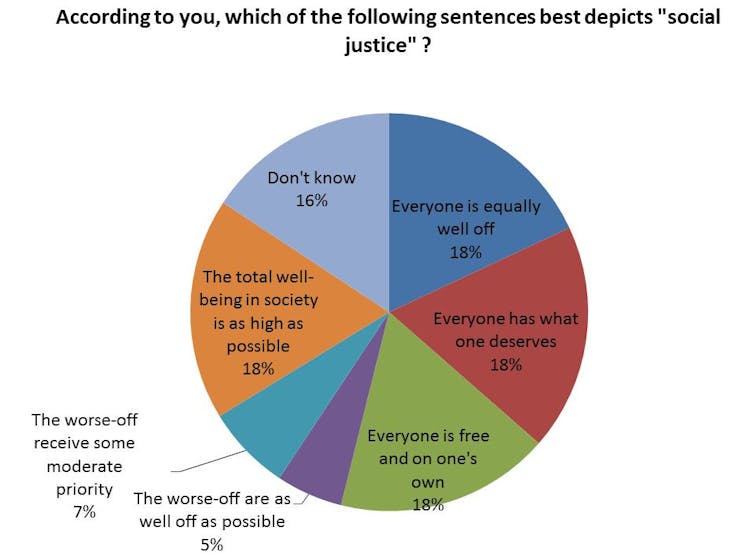
The sample is divided on this question mostly across political lines: the more progressive respondents support egalitarianism and Rawls’ approach more than average and support libertarianism and the desert approach less than average, whereas conservatives support utilitarianism less than average. There is no significant gender or religious difference, and very little difference across income levels or education levels. Age also does not matter much, except that the younger respondents support egalitarianism more than average.
Key values and principles
The support for the key values that pervade the discourse about social justice is overall very strong. It is interesting to see that human rights and dignity, key values in the United Nations’ Agenda 2030 for Sustainable Development Goals are at the top. Opportunities and well-being are also very high. Freedom and equality, often considered in tension, nicely come together behind. It may be surprising that democracy and solidarity receive less support, though still quite high.
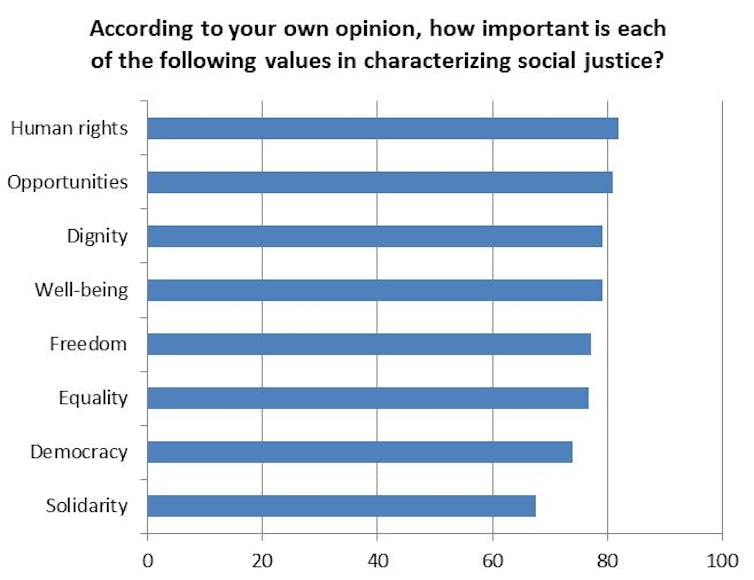
Looking at who expresses support for these values, one finds that middle-aged respondents support all values more, except opportunities and solidarity. The non-white show more support than average for equality, democracy and solidarity. Those with no high-school diploma show less support for democracy than all those with at least a high-school diploma. The more liberal respondents show greater support than average for all values except freedom. The more religious respondents show greater support than average for well-being, democracy, opportunities and solidarity.
The next table tests the sample’s support for various ideas which are debated in social justice circles. There is strong support for notions of respect and responsibility, and quite substantial, but significantly lower, support for the “sufficientarian” view that bringing everyone to a minimal threshold is enough.

The idea that it is enough to provide opportunities is supported more than average by the high-income or very religious respondents, and less than average by women, middle-aged, and politically moderate or liberal respondents.
The current situation is unjust
Is the situation in the world, and in the USA, roughly just? The average degree of support (on a scale between 0 and 100) for this statement is 50 for the world and 56 for the country, and the full distribution of answers is displayed in the following graph.
The graph shows that the respondents have a rather rosy view of the situation in the country: only 37% give a score below 50, and the same proportion give a score of 70 or greater. For the world, their view is more negative: 46% give a score below 50, and only 30% give a score of 70 or greater. The two curves are more distant for the low values than for the high values, showing that those who find the situation unjust are likely to find the world much more unjust than the country, whereas those who think that the situation is just do not see much of a difference between the country and the world.
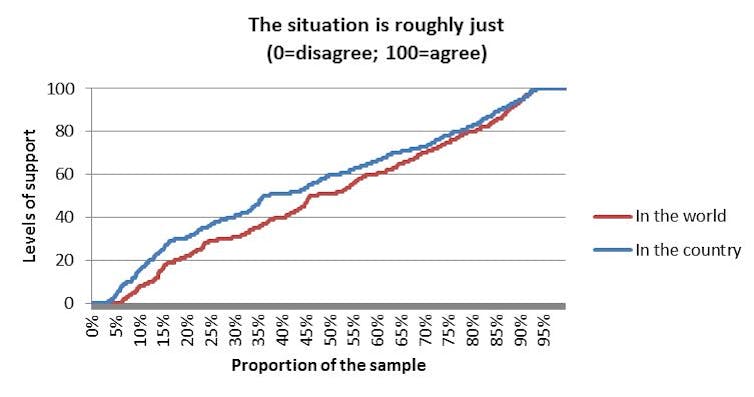
Note: To read this graph, pick a level of support (e.g., 40) and on the horizontal axis find the fraction of the sample that gives at most this level of support (for a level of support of 40, about 30% give at most this level of support for the country, and the corresponding proportion is 40% for the world).
Women, middle-aged and middle-income respondents see more injustice in the world than average, whereas minorities and religious respondents see more justice. For the country, the pattern is the same, but in addition the politically progressive respondents also see more injustice than average.
Those who gave a score below 50 were then asked to name the reasons why the situation is not just. It is interesting that inequalities at the top of the distribution appear a greater concern than poverty at the bottom. Inequalities, especially at the top, are a greater concern at the country level than at the world level. Freedom and opportunities are much less of a concern at the country level, confirming that Americans see their country as offering greater opportunities than in the rest of the world.
Whether the government is part of the problem or part of the solution is not clear, due to the division of the population on this issue, but consistently with the results of our survey on welfare policies, the sample is slightly in favour of greater government action.

In the sample, the more educated and the politically progressive give higher scores than average to the indictment of the better off. Government inaction is incriminated more by middle-aged and politically progressive respondents, whereas government action is pinpointed more by the middle-aged, by respondents with no political orientation, and by the slightly and the very religious respondents (government action receives a lower score from the elderly).
What does it mean to be badly off?
A thorny issue in debates about social justice is to define what it means to be badly off and to deserve some priority in social policies. This issue has been discussed in a January 2017 post by H. Richardson and E. Schokkaert. In particular, should one focus on those who feel miserable or on those who are more objectively disadvantaged?
The survey asked this question with an example referring to the well-known characters of Dickens’ Christmas Carol which have also been invoked by the philosopher Gerald Cohen.
The answers are very interesting. The respondents overwhelmingly reject the purely subjective approach, but only a third of them support the purely objective approach. Instead, they support a mixed view according to which well-being is a subjective notion (and therefore the happy Tim is better off) but social help should focus on objective advantage.
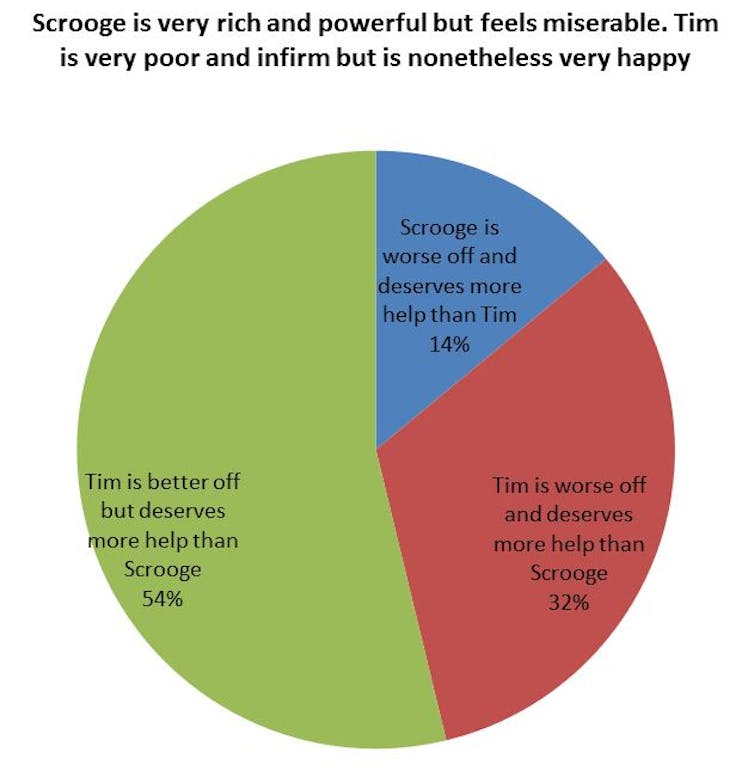
Note: Percentages in this graph represent fractions of the sample supporting the statement.
Pursuing on this issue, the respondents were asked to give weights to the various aspects of life that may put someone in a disadvantaged situation. Is it more a matter of wealth and income, or other non-monetary aspects? The answers are remarkably balanced and show great awareness that disadvantage can come in many different forms. Interestingly, objective dimensions obtain a much greater weight in total than happiness, which shows that the respondents are decidedly not willing to focus exclusively on subjective well-being in this context.
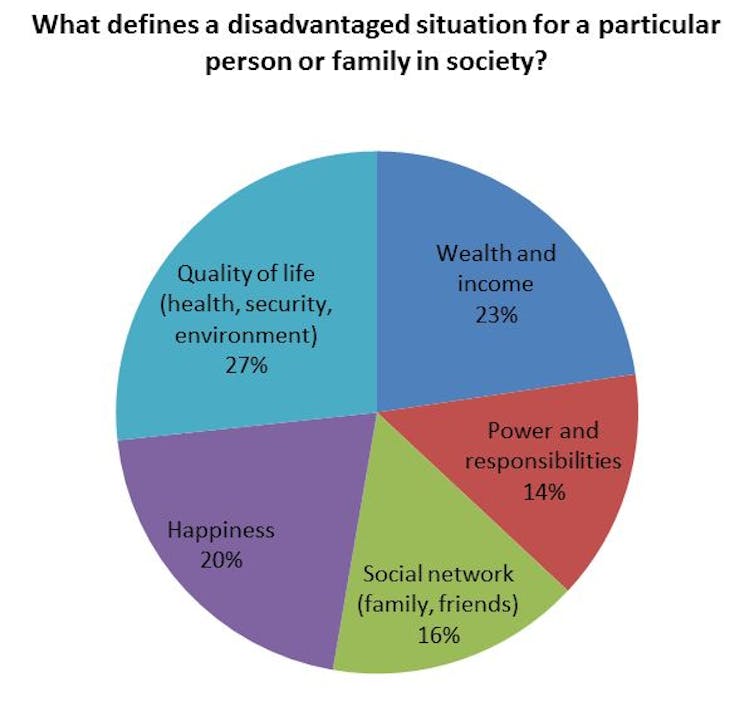
Note: The percentages in this graph represent the average weight given by all respondents to each particular aspect.
Hard trade-offs
Debates about social justice are full of puzzles and difficult tensions between conflicting principles. The survey asked about three of these puzzles.
First, gambles and wagers can be freely entered by people and preventing them from doing so would curb their freedom. On the other hand, they may generate strong inequalities (and the losers are likely to regret taking the risk). Between freedom and equality, which principle should prevail? The sample is more in favour of freedom, but an almost equal proportion also sees the problem with inequality. This is not just a tension for philosophers.

Another puzzle is the following. If one makes decisions by weighing the gains and losses accruing to different people, one may be afraid of sometimes giving priority to a great mass of people over a much smaller group, even if the stakes are negligible for each member of the former group and very important for each member of the latter group. Classical decision criteria in cost-benefit analysis and public policy evaluation do have this worrisome feature. The respondents overwhelming share the view that the sheer number of people should not always be able to tilt the balance, when the stakes are very high for the small group.

Finally, in a similar vein as the previous puzzle, if there is a value of having more people, can the sheer number of people make a poor population appear a better option than a smaller population living in affluence? Here the respondents are less sure but the greater share of the sample once again supports the view that the number of people cannot always carry the moral judgment.

These results confirm that the ongoing research by various authors such as Alex Voorhoeve and Gustaf Arrhenius aiming at finding alternatives to simple aggregative theories of justice (such as utilitarianism) that are willing to sacrifice minorities to large majorities and to favour large populations even when they are poor is in line with the moral intuitions of the larger public.





0 General Document comments
0 Sentence and Paragraph comments
0 Image and Video comments
New Conversation
General Document Comments 0

